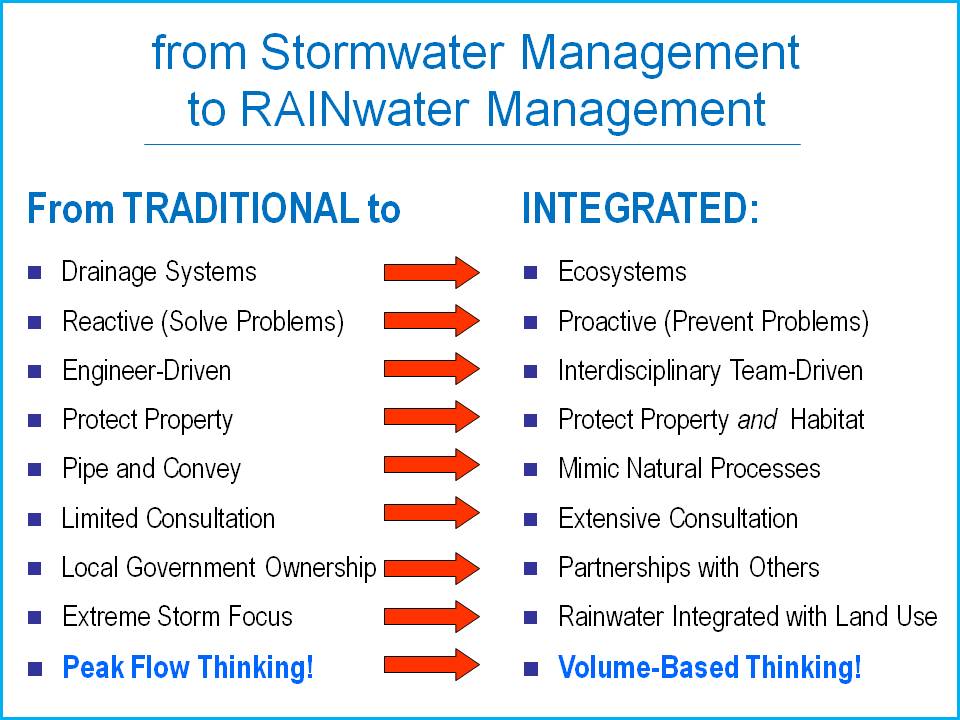Water Balance Model in the classroom: Richard Boase elaborates on new directions in urban watershed planning
Urban Watershed Planning
In April 2010, the Department of Civil Engineering at the British Columbia Institute of Tecnhology (BCIT) invited Richard Boase to inform faculty and 4th year students about new directions in urban watershed planning, highlighting the use of the Water Balance Model as a scenario modelling and decision support tool.
Richard Boase (District of North Vancouver) is Co-Chair of the Inter-Governmental Partnership that developed and maintains the Water Balance Model. A professional geoscientist, he is the District’s Environmental Protection Officer.
Landscape-Based Rainwater Management
“Rainwater management is landscape-based, is about managing the spectrum of rainfall events, and is at the heart of water-centric green infrastructure,” stated Richard Boase.
“Richard’s presentation showcased how more emphasis on natural landscapes featuring better use of soils and vegetation can help improve watershed health in the urban environment,” reports BCIT’s Colleen Chan.
Perspective on Sharing and Learning
“Richard provided a very engaging presentation to the members of the faculty and students regarding the impacts of single family redevelopment on water supply/demand and rainwater management.”
 “Richard’s enthusiasm and passion in the subject had a very positive impact on the faculty/ students. Many commented that his presentation has provided them with a deeper appreciation of the negative impacts of redevelopment on watershed health when careful rainwater management practices are not applied, and a better understanding of methods of mitigating the negative impacts through the use of natural landscapes.”
“Richard’s enthusiasm and passion in the subject had a very positive impact on the faculty/ students. Many commented that his presentation has provided them with a deeper appreciation of the negative impacts of redevelopment on watershed health when careful rainwater management practices are not applied, and a better understanding of methods of mitigating the negative impacts through the use of natural landscapes.”
“Additionally, Richard’s presentation drove home the message that an engineer also has the responsibility in helping to educate the public regarding the impacts on watershed health, in order for the rainwater management scheme to be successful.”
“Richard’s presentation will be immensely valuable to the students as they prepare to venture out into the world as young engineers,” concludes Collen Chan.
To Learn More:
A decade ago the SmartStorm Forum Series set in motion a chain of events that are still reverberating in British Columbia — Looking back, and in terms of ‘green’ rainwater management, much of what has happened in British Columbia can be traced back to October 1997 and who was in the room when the Union of BC Municipalities convened a focus group workshop on the Fish Protection Act.
Rainwater/Stormwater Management: Build a vision, create a legacy is the “Tenth Paradigm” — In a 2001 magazine article, Andy Reese identified nine paradigms to describe the evolution of stormwater management in North America. This story describes a tenth paradigm that is the guiding philosophy in British Columbia, and reaches beyond stormwater and associated professionals to engage broader society. The ‘Tenth Paradigm’ envisons a wholesale transformation of society’s relationships with water.
Well, What is Rainwater Management, Really? — By 2007, the time had come to focus drainage engineers and other practitioners on the integrated and holistic approach that is captured by the term RAINwater management.
“Topsoil Primer Set” connects the dots between rainwater management and drought management — The ‘Law & Policy’ and ‘Technical’ primers are built on the experience the Green Infrastructure Partnership has gained, since 2004, in promoting green infrastructure approaches to development in BC. Soil depth creates a sponge…. which can limit runoff during wet-weather periods; and reduce water need during dry-weather periods.
Beyond the Guidebook 2010: Paradigm-shift from ISMP to ‘Integrated Rainwater Management Plan’ — Beyond the Guidebook 2010 describes the evolution of an integrated approach, one that envisions achieving water sustainability through implementation of green infrastructure policies and practices.
District of North Vancouver’s Bold Vision: Restore the Rainfall Capture Capacity of the Urban Landscape, One Property at a Time — The catalyst for pending action is the current incremental impact of property redevelopment on stream health. North Vancouver’s watersheds have been experiencing death by a thousand cuts as the house footprint has grown larger and larger over the decades.
How the Tree Canopy Protects Urban Stream Health: “The right trees in the right places intercept rainfall”, says IGP Co-Chair Richard Boase — Trees can intercept upwards of 50% of the rain that falls each year on a watershed. Removing the tree cover means that more and more rainfall is converted into runoff volume.



